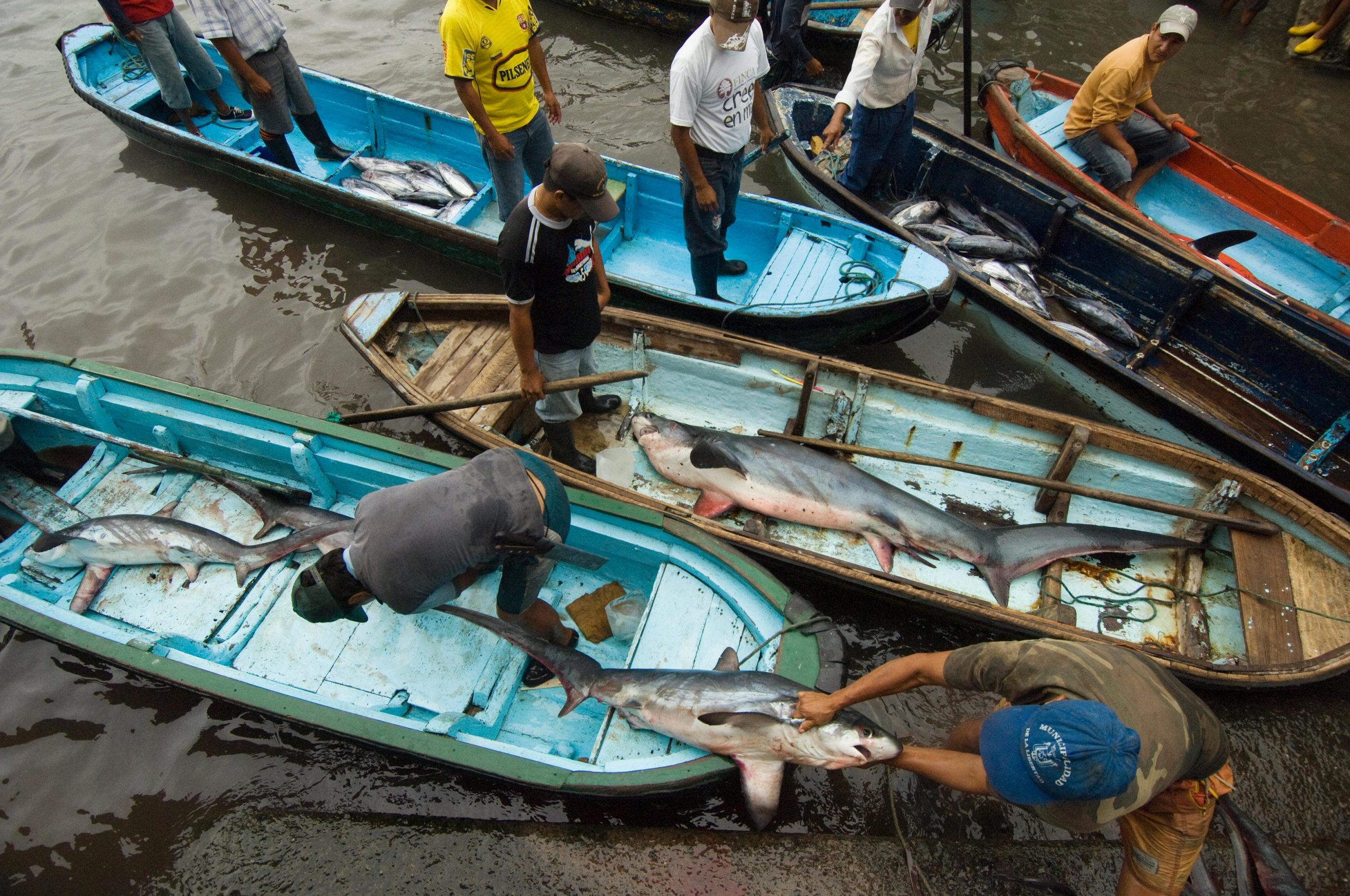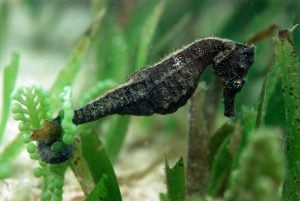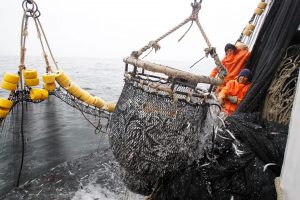“Better an honest enemy than a false friend”, the saying goes. Unfortunately, the sharks of the eastern Pacific Ocean may have one of the latter in Ecuador. Despite decades of legislation to protect sharks, the Latin American country has also allowed its semi-industrial fishers to catch them in large numbers.
Humans have been fishing for open ocean species for at least 20,000 years. Yet in just the last 50, the abundance of sharks has declined 71%, mainly due to a steep increase in commercial fishing and bycatch. This is a blink of an eye, considering the evolutionary branch of sharks and other cartilaginous fish dates back around 400 million years.
The international community has made steps to address the issue, establishing bodies to help conserve and sustainably manage biodiversity impacted by fisheries. Known as regional fisheries management organisations (RFMOs), they place a particular emphasis on species like sharks that share the waters of coastal states and the high seas beyond.
The very first area to have an RFMO was the eastern Pacific, home to some of the world’s most biologically productive marine ecosystems. The creation of the Inter-American Tropical Tuna Commission (IATTC), in 1949, preceded the UN Convention on the Law of the Sea and the subsequent UN Fish Stocks Agreement by three and four decades respectively. But despite its head start, the IATTC, like the other dozen RFMOs that would follow, have largely failed to protect sharks and their cartilaginous relatives.
This is in part because some countries have impeded adequate data collection or used their vetoing power to hamper attempts by RFMOs to establish sustainable mortality limits for shark species (that is, making sure birth rates are above death rates). Some nations, on the other hand, have made notable efforts to protect these species, including Palau, which has prohibited shark fisheries. There have been some progressive actions within industry, too. South Korean multinational Dongwon, for instance, has committed to no-retention policies, meaning they release any sharks caught. While initiatives such as Seafood Business for Ocean Stewardship (SeaBOS), which includes the 10 largest seafood corporations in the world, passed a strategy in late 2021 to reduce risk to endangered cartilaginous fish.
False friendships
At first glance, the sharks of the eastern Pacific Ocean have an ally in Ecuador. The coastal nation has for decades projected a strong commitment to shark conservation through legislative action. Ecuador prohibited the active targeting of sharks by its domestic fisheries in the 1990s, and in 1993 passed a law prohibiting finning without selling the meat. In 2006, it became one of the early signatories of the Food and Agriculture Organization’s International Plan of Action for Sharks.
A few short months ago, Ecuador took another bold step to protect sharks by announcing the expansion of the Galapagos Marine Reserve. Ecuador, which in recent years had denounced the threat that international vessels (such as Chinese-flagged Fu Yuan Yu Leng 999) posed to the health of its shark populations, appeared to be demonstrating leadership in protecting its marine natural heritage.
Yet sharks have been hit by other actions that have received less publicity. In 2007, the then president Rafael Correa issued a decree which in practice overturned the ban on shark fin sales and exports. Alex Hearn, a marine fisheries ecologist at Universidad San Francisco de Quito, told China Dialogue that the decree did not allow targeted shark fishing but did allow bycatch, and as no definition of bycatch was given, “it pretty much opened the floodgates”.
Indeed, the unchecked capture of sharks in the eastern Pacific Ocean by distant-water fishing fleets does represent a serious threat, as no quotas, bycatch or mortality limits exist. But, at the same time as denouncing that, Ecuador has kept its own semi-industrial shark fishing operations out of the spotlight. In theory, Ecuador does not allow targeted shark fisheries, but official catch statistics reported to the FAO reveal it is the largest shark-fishing nation in the southeast Pacific, accounting for 40% of the catches there between 1990 and 2016. Maximiliano Bello, an ocean policy expert in the region, says this can be done in plain sight as “target species are hidden under the term ‘bycatch’”. He told China Dialogue that up to 90% of sharks caught are labelled bycatch.
These statistics can be largely attributed to Ecuadorian boats fishing for large pelagics – species that inhabit the upper layers of the open ocean. A 2015 study revealed that this semi-industrial fishery caught and retained around 260,000 sharks each year between 2008 and 2012 – 50 times more than the Fu Yuan Yu Leng 999. Accompanying these numbers, there is evidence suggesting that the export of shark fins by Ecuador grew 635% between 2013 and 2021, earning the top three exporting companies’ profits ranging from US$3.8 million to $6.5 million. This raises questions as to why the international community should continue engaging in debt swaps with the coastal nation to expand its national marine reserves if the very same sharks they are intended to protect are then targeted a few miles further offshore.
How to do better?
When, where and how you fish influences what species you catch. If Ecuador wants to demonstrate its commitment to conserving sharks, it could start domestically, by improving fisheries management to try to reduce bycatch and enforce a non-retention policy, whereby any shark accidentally caught must be released in the best possible condition. Ecuador could also lead and galvanise other actors to establish sustainable management plans for sharks within the IATTC region, which is one of their responsibilities under the 1995 UN Fish Stocks Agreement.
They don’t recognise the shark fishery, but they call it a shark fishery!Alex Hearn, Universidad San Francisco de Quito
Conserving highly mobile shark species in the eastern Pacific Ocean, or any other region, does not depend on the actions of any one coastal, island or distant-water fishing nation.
According to Professor Hearn: “international pressure could work as well”, especially pressure from markets such as the EU. While Ecuador’s fleet targets mahi mahi for half of the year, the other half engage in the “APT fishery”. This Spanish acronym stands for tuna, billfish and shark. Hearn points out the irony: “They don’t recognise the shark fishery, but they call it a shark fishery!”
Hearn says banning the landing of these animals would not be enough, as dozens of shark species would still end up as bycatch. It is therefore important to implement bycatch-reduction methods, such as avoiding certain areas of the eastern Pacific Ocean. “But we don’t have good spatial data on catches in Ecuador: the system is not transparent and this is key to improving fisheries management in the region”, Hearn said.
As we head into what may well be the final years to reverse the decline of many shark species, transparency about catch and mortality rates are more important than ever. In that regard, honest enemies may represent better shark allies than false friends.









